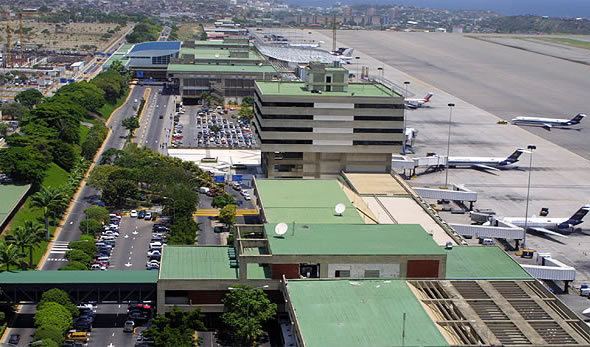Airport type Public Code CCS Phone +58 212-3552420 ext. 100 | Elevation AMSL 235 ft / 72 m Elevation 72 m | |
 | ||
Hub for ConviasaLASER AirlinesAeropostalAserca AirlinesSolar CargoTranscarga Address Avenida La Armada, Maiquetía 1161, Vargas, Venezuela Hours Open today · 5AM–11PMWednesday5AM–11PMThursday5AM–11PMFriday5AM–11PMSaturday5AM–11PMSunday5AM–11PMMonday5AM–11PMTuesday5AM–11PMSuggest an edit Similar Eurobuild Express Maiquetia, Hotel Miramar Suites, Hotel Catimar Puerto Vi, Hotel Aeropuerto Suites, Edificio sede de CONVIASA Profiles | ||
Simón Bolívar International Airport or Maiquetía "Simón Bolívar" International Airport (IATA: CCS, ICAO: SVMI, Spanish: Aeropuerto Internacional de Maiquetia "Simón Bolívar") is an international airport located in Maiquetía, about 21 kilometres (13 mi) from downtown Caracas, the capital of Venezuela. Simply called Maiquetía by the local population, it is the main international air passenger gateway to Venezuela among the twelve international airports in the country. It handles flights to several major destinations in the Americas, the Caribbean and some in Europe.
Contents
History
The airport opened in 1945 as the Aeropuerto Internacional de Maiquetía. The site had been recommended as an appropriate location for an airport by Charles Lindbergh on behalf of Pan Am. The USA subsidized the construction of the airport as part of the Airport Development Program. Luis Malaussena was the architect who designed the original passenger terminal.
It was regularly visited by the Anglo-French supersonic airliner Concorde until the 1980s. Commencing in the late 1970s, Air France operated weekly Concorde service between Caracas and Paris via a stop at Santa Maria Airport (Azores) located in the Atlantic Ocean.
Between 1952 and 1962, two new wings were added to the passenger terminal, and the runway was expanded to 2000 m. Lighting was installed on the runway and approach zones to allow night operations. In 1956 a new runway was built, and in 1962, it was expanded to 3000 m long by 60 m wide.
In the 1970s a new international terminal was constructed to offer increased capacity with a domestic terminal opening in 1983. Since 2000, the airport has been undergoing major changes in order to meet international standards and to improve passenger traffic, security, immigration areas, and customs areas. Security measures have become top priority since the September 11 attacks, and now departure areas and arrival areas are completely split into the lower and upper levels of the airport. The Proyecto Maiquetía 2000 (Project Maiquetia 2000) was completed in 2007 which added new customs and immigrations areas, a new cargo terminal, and a connecting passageway between the domestic and national terminal.
As part of an expansion plan, new international gates are currently in construction, and a section of the parking area has been cleared to build an airport hotel. In the 1950s, under the regime of Marcos Pérez Jiménez, road transport between the airport and the capital was improved by the inauguration of the Caracas-La Guaira highway. However, the La Guaira and Caracas Railway, dating from the nineteenth century, was closed. In May 2007 a maglev train was proposed to link Caracas to La Guaira and Simón Bolívar International Airport. In light of the current situation in Venezuela, the maglev train is not expected to be operational soon. In 2016 the old jetways in the international terminal were replaced with new 'glass wall' jetways.
Other facilities
From 1960 to 1997, it was the main hub for Viasa, Venezuela's former flag carrier until it went bankrupt. As well as it was the hub for Avensa, Servivensa. Conviasa (Consorcio Venezolano de Industrias Aeronáuticas y Servicios Aéreos, S.A.) started operation since 2004 hoping to become in a big and leader airline, and flag carrier, proud of the Venezuelan eight stars flag, however due to financial crisis in the Bolivarian Nation several pilots quit and are leaving this company in order to fly to other nations like Turkey which operates the same type of aircraft Embraer 190. The headquarters of Conviasa is located on the airport grounds.
Accidents and incidents
In popular culture
The airport is shown on the movie Menudo: La Película, when a pair of Menudo's friends board a flight during the film's final scenes. The airport is also shown in the 1975 French film "Le Sauvage" [Call me Savage, UK Title] starring Catherine Deneuve, Yves Montand Luigi Vannucchi and Tony Roberts, directed by Jean-Paul Rappeneau, as several soap-opera and movie key scenes were filmed at the airport.
